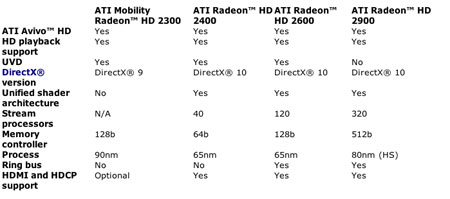
AMD annuncia l’inizio della distribuzione dei primi processori grafici ATI Radon HD 2400 e ATI Radon HD 2600, ai principali produttori.
Ati Radeon HD
AMD annuncia l’inizio della distribuzione dei primi processori grafici ATI Radon HD 2400 e ATI Radon HD 2600, ai principali produttori. Le nuove schede ATI Radeon liberano le potenzialità di DirectX 10 nei giochi e nei video ad alta definizione per Window Vista.
Le schede grafiche, basate su questi processori, saranno disponibili entro poche settimane presso numerosi partner come Asus, Club 3D, Diamone Multimedia, GeCube, Gigabyte, HIS, MSI, Palit, PowerColor, Sapphire e VisionTek.
Entrambi i processori grafici integrano l’innovativa tecnologia UVD (Unified Video Decoder), il cui compito è quello di gestire tutti i flussi video, sia in standard che in high definition, sgravando il processore di sistema dall’esecuzione di queste operazioni.
AMD vuole inoltre precisare che la tecnologia UVD è presente sui processori ATI Radon HD 2300, ATI Radon HD 2400 e ATI Radon HD 2600, ma non sulla serie ATI Radon HD 2900.
Di seguito il comunicato ufficiale in lingua inglese:
ATI Radeon 2400 and ATI Radeon 2600 Now Shipping to Board Customers
Sunnyvale, Calif. – June 11, 2007 – AMD (NYSE: AMD) is now shipping ATI Radeon HD 2400 and ATI Radeon HD 2600 graphics processors in volume to its board customers. The ATI Radeon HD 2400 and ATI Radeon HD 2600 deliver feature-rich DirectX 10 gaming and high definition video for Windows Vista. Graphics cards based on these processors are expected to be available at online retailers within a few weeks from board customers including Asus, Club 3D, Diamond Multimedia, GeCube, Gigabyte, HIS, MSI, Palit, PowerColor, Sapphire and VisionTek.
Both graphics processors feature AMD’s innovative UVD (Unified Video Decoder) technology. UVD is a hardware feature that offloads video decoding from the CPU to the GPU (Graphics Processing Unit) to significantly lower system power consumption. This is particularly important for media center PCs (because lower power consumption means quieter cooling solutions) and notebooks (where power consumption dictates battery life). UVD is designed to be used in a range of video applications, for example, watching Blu-ray, HD DVD or standard definition movies.
AMD also wishes to clarify any confusion that may exist regarding the presence of the Unified Video Decoder (UVD) in its ATI Radeon HD 2000 series graphics processors. UVD is present in the ATI Mobility Radeon HD 2300, the ATI Radeon HD 2400, and the ATI Radeon HD 2600 series products, but is not present in the ATI Radeon HD 2900 series products as it is not needed due to the usage model of this high end product.
The ATI Radeon HD 2400 and ATI Radeon HD 2600 cards are designed for use in entry-level and mainstream systems, in which the UVD technology is beneficial for watching high definition movies. In contrast, the ATI Radeon HD 2900 XT is a high-end desktop card for gaming enthusiasts, and designed to be used in high-performance PCs with the fastest CPUs. In these environments, the CPU can perform software decoding of HD video without being overburdened and UVD technology is not required. The user will get a high-quality video experience (including watching Blu-ray or HD DVD movies) with any ATI Radeon HD 2000 series card.

